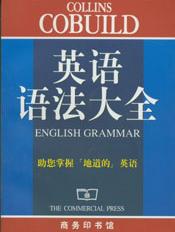牛津实用英语语法-第30章
按键盘上方向键 ← 或 → 可快速上下翻页,按键盘上的 Enter 键可回到本书目录页,按键盘上方向键 ↑ 可回到本页顶部!
————未阅读完?加入书签已便下次继续阅读!
过去一般式 he worked(参见第175节。)
进行式 he was working(参见第178节。)
完成式 he had worked(参见第 194节。)
完成进行式 he had been working(参见第197节。)
将来一般式 he will work(参见第201节。)
进行式 he will be working(参见第211节。)
完成式 he will have worked(参见第216节。)
完成进行式 he will have been working(参见第216节。)
现在 条件语气 he would work(参见第219节。)
条件进行式 he would be working(参见第219节。)
完成 条件语气 he would have worked(参见第220节。)
条件进行式 he would have been working
B 肯定式的缩略式
助动词be,have,will,would的缩略形式如下:
am牋牋牋牋牋牋牋牋 ′m
is牋牋牋牋牋牋牋牋牋 ′s
are牋牋牋牋牋牋牋牋 ′re
have牋牋牋牋牋牋牋 ′ve
has牋牋牋牋牋牋牋?′s
had牋牋牋牋牋牋牋?′d
will牋牋牋牋牋牋牋?′ll
would牋牋牋牋牋?′d
注意:′s可以表示is或has;′d可以表示had或would:He′s going.相当于:
He is going.
他要走了。
He′s gone.相当于:
He has gone.
他已走了。
He′d paid.相当于:
He had paid.
他已付过了。
He′d like a drink.相当于:
He would like a drink.
他想要杯喝的。
这些缩略形式用于代词here,there,某些疑问词(参见第104节)和短的名词之后:
Here′s your pen.
你的钢笔在这儿。
The twins′ve arrived.
双胞胎已经到了。
The car′d broken down.
车坏了。
肯定式的缩略式不用于句末:
You aren′t in a hurry but I am.
你不着急,我可着急。(此处不能用I′m。)
shall,should,was和were没有书面的缩略形式,但在口语中常读为/Ml/,/M+d/,/w+z/和/w+(r)/。
C 重音
通常助动词被用来构成时态时不重读,而主要的动词应重读。
?
'Amber demo'
103 各种时态的否定形式
?
A 一般现在时的否定式:第三人称单数为does not/doesn′t+动词原形;所有其他人称为do not/don′t+动词原形。一般过去时的否定式:所有人称都是did not/didn′t+动词原形。
口语中较常用的缩略形式举例如下:
He does not/doesn′t answer letters.
他从不给人回信。
They do not/don′t live here.
他们不住在这儿。
I did not/didn′t phone her.
我没打电话给她。
She did not/didn′t wait for me.
她没等我。
其余的时态的否定式都用在助动词后加not的方法构成。口语中可用缩略形式:He has not/hasn′t finished.
他还没有完成。
He would not/wouldn′t e.
他不会来。
B 否定式的缩略形式
助动词be,have,will,would,shall,should,do的缩略形式如下:
am not牋牋牋牋 ′m not
is not牋牋牋牋牋 isn′t/′s not
are not牋牋牋牋 aren′t/′re not
例句如:
I′m not going and Tom isn′t/Tom′s not going.
我不去,汤姆也不去。
We aren′t going./we′re not going.
我们不去。
have not和has not的缩略形式是haven′t和hasn′t,但在完成时态中′ve not和′s not也是可以的:
We haven′t seen him./We′ve not seen him.
我们没见到过他。
He hasn′t/He′s not e yet.
他还没来。
will not的缩略形式是won′t,但′ll not也是可以的。 shall not的缩略形式是shan′t:
I won′t go/I′ll not go till I hear and I shan′t hear till tomorrow.
没有听到音信以前我不去,而我要到明天才能听到音信。
其他动词的缩略形式是按常规加上n′t。
否定式的缩略式可置于句末:
I saw it but he didn′t.
我看见它了,可他没看见。
C 英语中,一个否定句只能在句中有一个否定的表达方式,而双
重否定就会使句子具有肯定的含义:Nobody did nothing意指人人都干了点事。
因此,never,no(形容词),none,nobody,no one,nothing,hard- ly,hardly ever等词都和肯定动词连用。可以说:
He didn′t eat anything./He ate nothing.
他没吃东西。
He doesn′t ever plain./He never plains.
他从来不抱怨。
We haven′t seen anyone./We have seen no one.
我们谁也没看见。
They didn′t speak much./They hardly spoke at all./They hardly ever spoke.
他们没有说什么。
?
'Amber demo'
104 表示疑问和请求的疑问式
?
A 关于一般现在时的疑问式,第三人称用does he/she/it+动词原形,其他各人称用do I/you/we/they+动词原形。
关于一般过去时的疑问式,各人称都用did+主语+动词原形:
Does Peter enjoy parties?
彼得喜欢参加聚会吗?
Did he enjoy Ann′s party?
他在安的聚会上玩得开心吗?
至于其他各时态,则通过把主语放在助动词之后的方法来构成疑问式:
Have you finished?
你完成了吗?
Are you ing?
你们来吗?
B 用于疑问句中的助动词的缩略形式
1 am,is,are,have,had,will和wouldhow,what,who,where,why这一类词后的缩略形式正如第102节B节中所示:
How will/How′ll he get there?
他将怎样到那里去?
What has/What′s happened?
发生了什么事?
is和will在when之后也可以有缩略形式:
When is/When′s he ing?
他什么时候来?
will在which之后也可有缩略形式:
Which will/Which′ll you have?
你要哪一个?
如上面A中所示,如动词在前,除了在书面的否定疑问式中可以缩略之外,其他情况下在书面语中都没有缩略形式。但通常在口语中都用缩略形式。
2 shall,should,do和did没有书面缩略形式,虽然有时可将do you写成′d you。在口语中shall,should和do you常常读为/Ml/,/M+d/,/dju:/。
C 疑问式用于疑问句,但不用于下列场合:
1 如问句问的是主语是什么人或什么东西时:
Who told you?
谁告诉你的?
What happened?
出了什么事?
2 在间接引语中时:
He said,‘Where does she live?’
他问道:“她住在哪里?”相当于:
He asked where she lived.
他问她住在哪里。
3 如果我们在一个问句之前加上像Do you know,Can you tellme, I want to know,I′d like to know,I wonder/was wondering,Have you any idea,Do you think等这样一些语句时:
What time does it start?
什么时候开始?
但是说:
Have you any idea what time it starts?
你知道什么时候开始吗?
Where does Peter live?
彼得住在什么地方?
但是说:
I wonder where Peter lives.
我很想知道彼得住在什么地方。
Will I have to pay duty on this?
我必须为此纳税吗?
但是说:
Do you think I′ll have/Do you know if I′ll have to pay duty?
你认为我必须/你知道我是否必须交税?
D 请求通常用疑问句表示:
Can/Could you help me?
你可以帮助我吗?
Will/Would you pay at the desk?
请您到收款处交款,好吗?
Would you like to e this way?
请您这边来,好吗?
Would you mind moving your car?
请您移动一下汽车,好吗?
但也可以在请求之前加上I wonder/was wondering或Do you think等这样一类短语,这时用于表示请求的动词就从疑问式变为肯定式(即陈述式):
Could you give me a hand with this?
请您帮我拿一下这东西好吗?
但是说:
I wonder/was wondering/wondered if you could give me a hand.
我不知道您是否能帮我一把。
Do you think you could give me a hand?
您能帮我一把吗?
在间接引语中不会引起问题,因为间接请求是用像ask这一类动词加上宾语+不定式来表示的:
He asked me to give him a hand.
他要我帮他一把。
E 疑问式常用在否定动词之后的附加疑问中:
You didn′t see him,did you?
你没有见到他,是吗?(参见第110节。)
F 为了表示强调而把never,rarely,seldom,only,when,only by, not only,not till这一类词或短语放在句首时,随后的主要动词要用倒装形式(与疑问式相同):
Only when we landed did we see how badly the plane had been damaged.
我们只是在着陆之后才看到飞机损坏的严重程度。(参见第45节。)
?
'Amber demo'
105 否定疑问式
?
A 这一形式是在普通疑问式之后加上not而构成的:
Did you not see her?
你没有看见她吗?
Is he not ing?
他不来了吗?
但这种形式几乎总是变为缩略形式:
Didn′t you see her?
Isn′t he ing?
注意:not的位置是在主语之前。
am I not的缩略形式是不规则的,为aren′t I。
B 当说话人预期或希望得到肯定答语时,常用否定疑问式:
Haven′t you finished yet?
你还没有结束吗?
Don′t you like my new dress?
你不喜欢我的新衣服吗?
Child:Can′t I stay up till the end of the programme?
孩子:我看完这个节目再去睡觉不行吗?
—I could wait ten minutes.
—Couldn′t you wait a little longe






